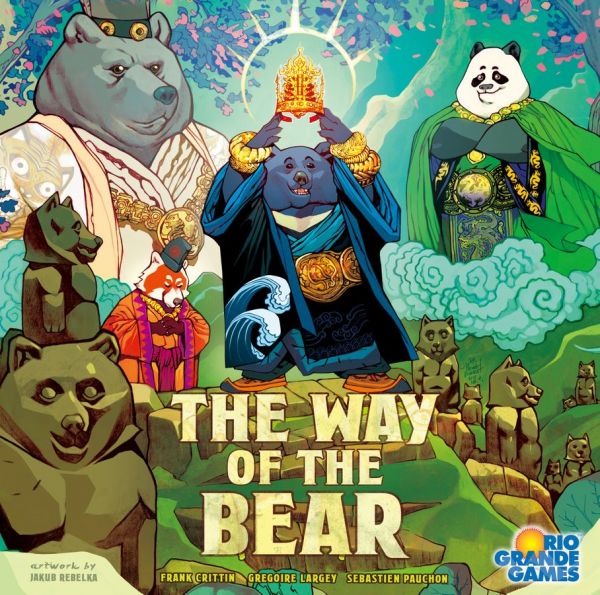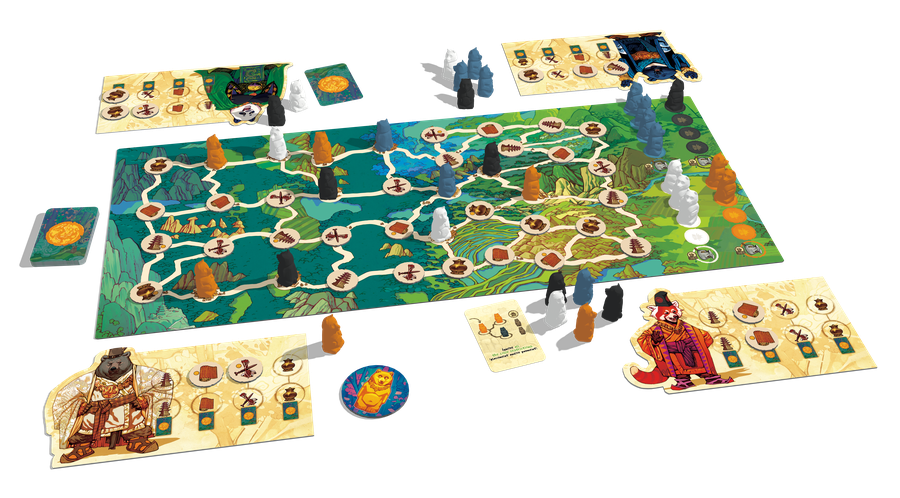Race to Become the Next Emperor in The Way of the Bear

Formerly known as Wangdo, the rebranded The Way of the Bear cleverly utilizes area management and set collection in a quick, but potentially brain-burning casual game.
Gameplay
The Way of the Bear is a 2-4 player game that tasks players with collecting sets of chits to become the new Emperor of the four bear clans. Setup begins with players choosing one of the clan boards and blindly picking three bears (bears are colored black, blue, orange, and white) from the bag. Board setup is dependent on the number of players, with an additional section added for 4-player games. Chits, known as knowledge tokens, are turned upside down, shuffled, and placed on the circular areas of the board (some chits will be removed in 2-3 player games). Chits are then turned over to reveal the symbols on each, with four bear symbols being replaced by four bears randomly drawn from the bag.
The object of the game is to place bears along the path to collect a set number of knowledge tokens (two of each in a 3-4 player game, three of each in a two-player game) to complete sets on their clan board. Players must place a bear next to a space that is occupied by another bear and then pay tribute to one of the four temples.
However, it’s not quite as simple as it seems. Bears being played may not be the same color as the one adjacent to it, yet players will need to pay tribute by matching the color of the adjacent bear. For example, if a player is collecting a lantern chit from a space next to an orange bear, they may play any color bear that is not orange in that space but must then place an orange bear from their supply onto the orange temple track. If a player is unable to meet the requirements of any open space that is directly connected to bears on the same path, they must spend their turn drawing three bears from the bag. Once a temple track receives its fifth bear, the track is cleared by placing the bears back into the bag — with the player who placed the fifth bear being able to take any colored bear from one of the other temple tracks.
As players begin to acquire symbols and fill their clan cards with the required amount of knowledge tokens, they will earn a bonus in the form of a seal card. Seal cards offer powers that help players circumvent the rules (such as placing the same color of bear next to each other, paying one less of the temple cost to place, etc.) and allow a bit of strategic leniency.
Seal cards and knowledge tokens also contain dragon seals that will help in end-game scoring in case of ties. The game’s end is triggered when a player fills their clan card with all the necessary knowledge tokens. Play continues around the board in player order until the round naturally ends. In the case that multiple players entirely fill their clan cards, dragon seals are counted on acquired tokens and unplayed seal cards with the highest total winning the game.

Review
Despite its simplistic approach, simple rules, and streamlined gameplay, The Way of the Bear borrows much of its gameplay from more traditional area control games such as Chess and Go. During the early portions of the game, the cost of placing a bear and collecting any knowledge token is relatively cheap. Players will largely play a bear, pay the temple cost, and then spend their next turn drawing three bears and then repeating actions. However, as temple tracks are filled and emptied, paths begin to intertwine, and bears begin populating all areas of the map, the game takes a more dramatic turn that requires some forethought. This limits the racing element of the game in the best possible way and keeps turns in a virtual dead-heat of knowledge token collection for much of the game.
As simple as the restrictions are (no placing bears of the same color next to each other and no collecting of knowledge tokens no longer available on a player’s clan board), they create limitations that collapse the game’s economy as it progresses. It also means a lot of player competition for spaces without devolving into a take-that game, because it’s the luck of the draw of both bears and seal cards.
It’s this luck that may be a turn-off for some. While The Way of the Bear’s area control is reminiscent of classic board games, the luck of drawing bears blindly from a bag can make or break a player as the placement costs escalate. If a player needs a pagoda knowledge token and the cost is three bears of different colors, it can be difficult to meet those demands without seal cards that mitigate the cost or circumstances. But there aren't enough opportunities to earn seal cards or to benefit from resetting a temple track and picking a bear from one of the other tracks.
Yet, The Way of the Bear perseveres. Though the map is stagnate, the beginning points will change from game to game, as will the layout of the bears, because of the different color combinations. While new maps in an expansion would ratchet up the replayability (and perhaps the difficulty for more hardcore board gamers), The Way of the Bear is a clever puzzler of spatial area management and set collection that doesn’t skimp on the quality of its components or brain crunch.
Pros: Variable gameplay, Quality components, Accessible design in terms of color and symbology
Cons: Luck-based mechanics may frustrate more serious gamers




